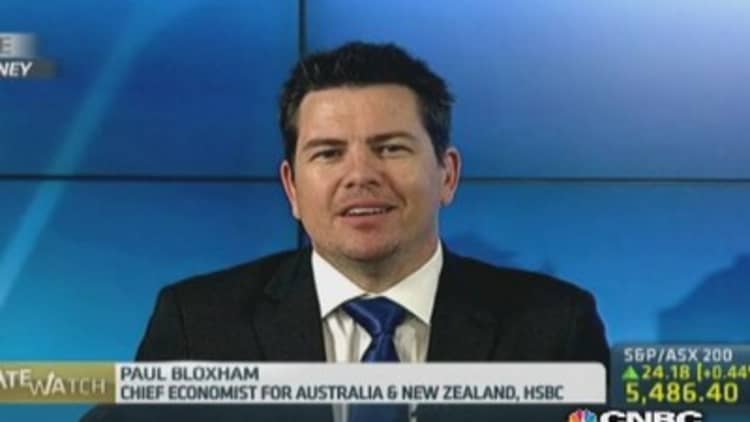As the Australian dollar pulled back further from its 2014 high this week amid more sub-par Chinese economic data, analysts say the commodities-linked currency may have topped out.
China's factory activity data contracted for the fourth straight month in April, the final Markit/HSBC Purchasing Managers' Index showed on Monday. The data knocked the Aussie down to $0.9250 on Monday, well below its yearly high of near $0.95. Although weak data out of the U.S. on Tuesday helped the Aussie pop back up above the $0.93 level again.
"The slowdown in Chinese manufacturing demand appears to be a significant long-term trend, and as such the news is likely to keep a cap on Aussie-greenback which saw some further selling pressure in Asian dealing Monday," said Boris Schlossberg, managing director at BK Asset Management.
Read MoreAustralia's nextwave of energy investment under threat
Schlossberg sees the currency falling much lower against the dollar over the course of the year, unraveling its 4.2 percent year-to-date rise against the dollar, aided by rhetoric from the Reserve Bank of Australia (RBA).
"Given the secular slowdown in demand from China, the RBA would prefer to see Aussie-greenback closer to the 85 cents level in order for the economy down under to rebalance itself. Therefore it is likely to keep jawboning, although for now it will most likely maintain a steadfastly neutral stance," he added.
On Tuesday Australia's central bank left the cash rate at a record low of 2.5 percent for the ninth consecutive month. Late last year Governor Glenn Stevens effectively talked down the currency when he said he would like to see the currency trading at 85 cents.
Read MoreSwan to Hockey: Stoptalking down Australia's economy
Emma Lawson, senior currency strategist at the National Bank of Australia, told CNBC she also believes the Aussie dollar has peaked. She said its failure to break above an important technical level of $0.9450 in mid-April indicated any further upside was limited.
"The uncertainty in the China data has led to downside for the Aussie, while the RBA noted today how the weakness in commodity prices like iron ore was likely to take its toll on the currency," she said, noting that she saw the Aussie at 84 cents by year-end.

However, unlike BK Asset Management's Schlossberg, Lawson said she did not see the RBA intervening in the currency's level this year.
"They've stepped away from open mouthed operations, which caused volatility in the past," she added.
Meanwhile Paul Bloxham, chief economist at HSBC, said the Aussie dollar was trading at fair value at the moment, with the potential to edge down slightly on U.S. dollar strength.
Read MoreGive China credit onyuan: Australian Treasurer
"I don't think the Aussie dollar is particularly high. It's around about the sort of level that will make the Reserve Bank fairly comfortable at the moment," he said.
Bloxham played down concerns about China's slowing economy and its potential to knock the Aussie down further.
"We recently got numbers from Port Headland [Australia] - the largest iron ore port in the world - which showed iron ore exports in volume terms were up 50 percent year on year to April and that's somewhat counterintuitive - as China's indicators have been slowing down," said Bloxham.
"Yes the manufacturing industry [in China] is slowing but actually growth is being well supported by housing and infrastructure construction, and that's the steel intensive part of the industry - it's domestic demand focused... and Australia is the world's cheapest producer of iron ore, so we are continuing to get support from China growth," he added.
In mid-morning trade in Asia on Wednesday the Aussie was trading at $0.9345.


